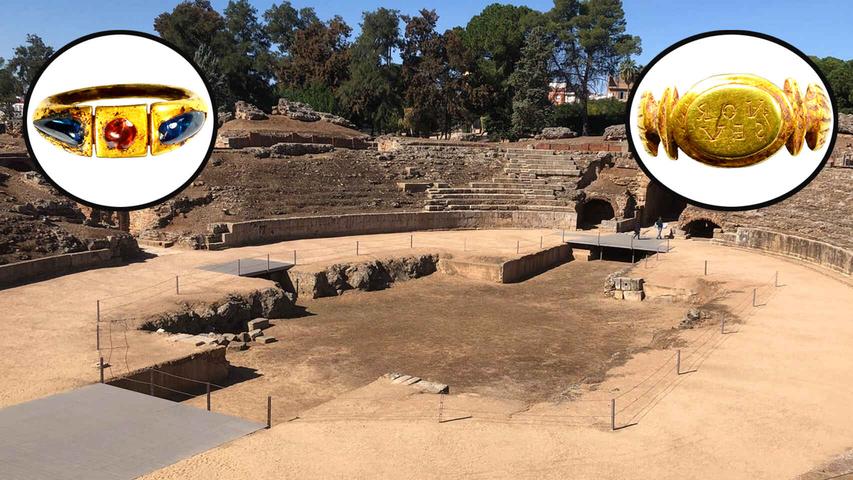The 80 unprecedented Roman jewels that reveal the fashion and superstitions of ancient Mérida
Related news
Norbana Severa was a woman who belonged to the Roman elite of Emerita Augusta around the 3rd century AD. Born in Lancia Oppidana, also in the province of Lusitania, she died at the age of 55. Her very pious mother, Julia Procula, buried her in a lead sarcophagus, in which she deposited a dazzling trousseau of gold jewelry, and dedicated a white marble funerary ara to her, found last century during excavations outside the amphitheater of the current Merida.
Among the objects deposited in the tomb of Norbana Severa, a gold ring stands out that its owner used as a personal seal, since six letters were engraved on the chatón —the first three of the name and last name— in negative to be able to read it correctly on the wax; another jewel of the same material with a small garnet in the center and two delicate blue teardrop-shaped gems on the shoulders; two moline, the name given by the Romans to the necklaces intertwined with gold thread and glass paste beads, pearls and precious stones; and a spectacular necklace with a gold bow chain and 32 octagonal green glass beads that matched some earrings.
These jewels are a handful of the eighty unpublished pieces, personal adornments used by men, women and children from Emerida in Roman times, which have just been presented by the Consortium of the Monumental City of Mérida through a book and a virtual exhibition with the title of The Brightness of Appearance. The objects, recovered in archaeological excavations carried out from 1986 to the present in old houses, garbage dumps and, above all, tombs dating between the 1st and 4th centuries of the present era, come back to light to describe the fashions of the provincial capital and narrate stories of superstition, luxury and individual biographies.
Ringing earrings (crotalia).CCMM

All these ornaments are a valuable source of information about the life and beliefs of Ancient Rome. Some gold earrings, completed with a double amulet representing a hand at one end and a phallus at the other, reflect its use as a protector against curses on the journey to the afterlife of an individual who died at a young age. But that same jewel could also herald the arrival of wealthy women: these are the crotalia, earrings with two or more suspended beads that made a sound when colliding and weighed so much that they could deform the ears. In Mérida they have been documented as part of the rich trousseau of a female subject from the 2nd-3rd century.
At first, the Roman emperors arrogated the power to award gold rings based on social privilege. They then relented based on economic status until finally allowing all free citizens to use them. In Emerita Augusta, valuable jewels have been recovered with stones on which the head of Athena or a running dog was engraved, and some even in the shape of a snake, a symbol of life and death, eternity, fertility, fecundity and the marital fidelity.
Amulets and paintings
According to the writer Pliny the Elder, gold objects intended for children prevented curses and poisons. That is why in a burial deposit dated between the end of the 2nd and the beginning of the 3rd century and full of children's amulets, a ring with an inscription was unearthed: the letters VT F, vt(ere) f(elix) ("wear it happily"). That is, happiness was wished to the owner of the jewel wherever he went. Poor parents who found themselves at the crossroads of burying their children had to look for less luxurious materials, such as bronze: in the suburban area of the circus a child burial from the first half of the first century was discovered in which a moon had been deposited made of bronze. A less ostentatious protection, but just as heartfelt.
To male children, as an amulet, their parents also gave them bullae (in Latin, drop of water), pendants that they had to wear until they came of age; while girls, for example, were given silver crescents —the Moon was related to fertility and healing—, which hung around their necks until their wedding day acted as a rejection of the evil eye or fascinum. Curiously, these pieces began to be used from the first century by soldiers, ready to cling to any supernatural hope in moments of uncertainty and fear.
Starting in the 2nd century, the Romans set coins in gold like gems, turning them into jewels, a fashion that extended throughout the 3rd and 4th centuries.CCMM
Gold, silver, amber, jet, gems, iron, bronze, vitreous pastes, emerald... These were the materials that made up the panoply of ancient Roman adornment and that find their reflection in the fascinating Mérida. It was also a fashion that was permeable to other cultures and civilizations, such as the Egyptians and their gods, and that was transformed over time towards a much more fashionable style thanks to the luxuries that entered the Urbs as part of the booties of war. Tradition vs modernity. And so until Christianity censored all objects that had to do with pagan cults.
A final attractive section of The Brilliance of Appearance is made up of the examples referring to Roman architecture. Marble is traditionally associated with white, but in Emerita Augusta other colored marbles, coming from the East, were used to embellish the floors of the curia or the forum of the colony and also as imperial propaganda.
Norbana Severa, the woman with the ostentatious trousseau of gold jewelry, was probably very wealthy, but no material record has survived to describe what she was like. It is the opposite of what happens with María Voconio, whose ashes were deposited in a ceramic urn at the beginning of the second century, inside the columbaria, the funerary building of her family. A portrait of this Roman woman was painted on a mural that shows her standing, dressed in a tunic and cloak, with the same posture and gesture as the marble sculptures of women with a high economic and social position. Her luxurious necklace, far from shining, has been tarnished by the passage of time.


